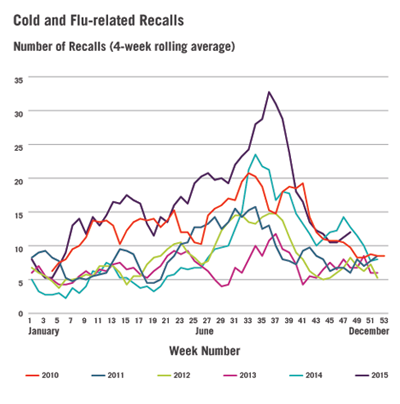Every year, flu season causes challenges for the Blood Service in the supply of products, both through donors being unable to donate and products being recalled due to donors reporting influenza-like illness in the week following donation.
Recent analysis by the Blood Service of the winter 2015 flu season found that in 2015, overall rates of influenza-like illness in the Australian community were slightly above 2014 levels, and similar to the rates seen in 2011 and 2012. Additionally, there are also dozens of other respiratory viruses which can cause cold and flu-like symptoms. Of course, when someone is unwell, no matter the cause, they aren’t able to give blood—meaning higher rates of illness-related cancellations for donors with an existing appointment and also fewer donors that the Blood Service can contact to make an appointment.
Additionally, the 2015 season saw an increase in the number of cold and flu-related product recalls, which was greater than in any year since 2010 (see graph). August/September 2015 saw several weeks where the number of recalls exceeded 25, including one stretch of four consecutive weeks of this level of recalls.
These combined factors ultimately did affect supply, with levels of group O red cells dipping below the Blood Service’s inventory sufficiency bands (the level at which we can comfortably meet customer demand) during the 2015 flu season.
“This is one of the reasons why analysing flu rates is so important,” said Stephen Wroth, the Blood Service Research Coordinator who prepared the paper.
“Understanding how and to what extent an unusually harsh flu season affects supply can help us manage and plan for future years.”
Graph: Cold and flu-related recalls per week

